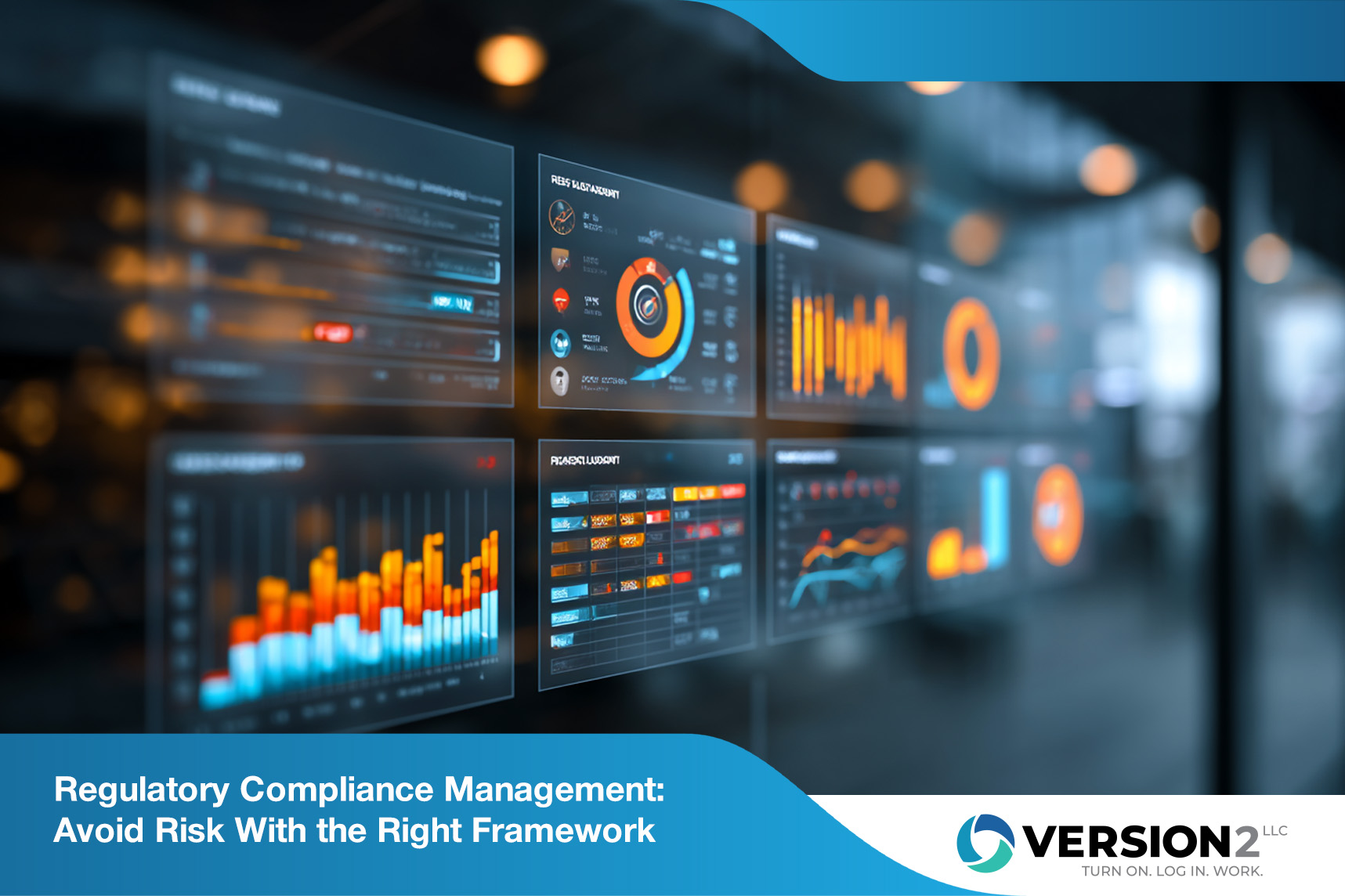
November 24, 2025
Business Password Management Tips to Protect Your Credentials
Learn how business password management helps protect your company from breaches, streamline access, and secure sensitive data with the right tools and policies.
November 25, 2025

Staying compliant with laws and regulations is more than a checkbox—it's a business necessity. Regulatory compliance management helps protect your company from fines, legal issues, and reputational damage. In this blog, you'll learn what it is, why it matters, and how to build a reliable system that supports your business goals. We’ll also cover common myths, key features, implementation tips, and how to avoid costly mistakes. Whether you're updating your compliance program or starting from scratch, this guide will help you stay ahead of regulatory changes and reduce compliance risk.
[.c-button-wrap][.c-button-main][.c-button-icon-content]Contact Us[.c-button-icon][.c-button-icon][.c-button-icon-content][.c-button-main][.c-button-wrap]
Regulatory compliance management is the process of ensuring your business follows all relevant laws, regulations, and industry standards. It includes creating policies, training staff, monitoring activities, and reporting on compliance efforts. This is especially important in industries like finance, healthcare, and manufacturing, where non-compliance can lead to serious consequences.
A strong compliance program helps you identify compliance requirements early, manage compliance risk, and avoid penalties. It also supports a culture of compliance, where everyone understands their roles and responsibilities. By using compliance management systems, you can streamline compliance processes and improve how your business responds to audits or regulatory changes.

Many businesses fall into traps that weaken their compliance efforts. Let’s break down six common myths and the truth behind them.
While legal teams play a big role, compliance is a shared responsibility. Senior management, department heads, and even entry-level employees must understand and follow compliance policies. Without this shared effort, gaps form quickly.
Compliance training isn’t a one-and-done task. Laws and regulations change, and employees need regular updates. Ongoing training helps your team stay informed and reduces the risk of non-compliance.
Having written policies is important, but it’s only one part of a full compliance framework. You also need monitoring tools, reporting systems, and clear procedures to ensure compliance across the board.
Modern compliance tools are scalable and often more affordable than dealing with fines or data breaches. They help you automate tasks, track changes, and improve compliance reporting.
Even small businesses face regulatory requirements. Without a formal system, it’s easy to miss critical steps. A simple compliance strategy can go a long way in protecting your business.
Done right, compliance can actually streamline business processes. It reduces confusion, improves accountability, and helps you meet regulatory expectations more efficiently.
A well-managed compliance program brings several advantages:

Compliance isn’t just about avoiding trouble—it’s about building a reliable business. When your team understands the purpose and scope of compliance, they make better decisions. This helps you meet regulatory requirements and avoid surprises during audits.
A strong compliance culture also improves your reputation. Customers and partners are more likely to work with businesses that take data protection and privacy regulations seriously. In industries with strict legal requirements, this can be a competitive advantage.
Creating a reliable compliance strategy takes planning. Here’s how to do it right.
Start by understanding the purpose and scope of your compliance efforts. Are you trying to meet industry-specific standards? Prepare for an audit? Reduce compliance risk? Clear goals help guide your decisions.
List all the laws and regulations that apply to your business. This could include GDPR, data privacy laws, or industry-specific rules. Knowing your regulatory landscape is key to staying compliant.
Designate a chief compliance officer or team to manage your program. Make sure everyone knows their roles and responsibilities. This avoids confusion and ensures accountability.
Create clear compliance policies and procedures. These should cover data security, reporting, and how to handle non-compliance. Keep them updated as regulations change.
Regular compliance training helps employees understand what’s expected. Include real-world examples and updates on changing regulatory requirements.
Use compliance tools to track your efforts. Schedule regular compliance audits to catch issues early. This helps you meet regulatory expectations and improve over time.
Compliance isn’t static. Review your compliance processes regularly and adjust your strategy as needed. This keeps your program effective and aligned with business goals.

To ensure compliance every day, integrate it into your business processes. Start by embedding compliance checks into workflows—like approvals, data handling, or vendor selection. This makes it easier to catch issues early.
Also, use compliance management systems to automate tasks like document tracking, employee certifications, and compliance reporting. These systems reduce manual errors and help you stay organized. Finally, encourage a culture of compliance by rewarding teams that follow policies and speak up about concerns.
Staying compliant takes ongoing effort. Here are some best practices to follow:
Following these steps helps you stay ahead of risks and build a stronger business.

Are you a business with 10 to 100 employees looking to improve your compliance systems? As your company grows, keeping up with compliance requirements becomes more complex—and more important. We help businesses like yours build practical, scalable compliance programs that reduce risk and support long-term success.
At Version 2, we understand the challenges of managing compliance in a changing regulatory environment. Our team works with you to create a custom compliance plan, implement reliable tools, and train your staff. Let us help you ensure compliance without slowing down your business.
[.c-button-wrap][.c-button-main][.c-button-icon-content]Contact Us[.c-button-icon][.c-button-icon][.c-button-icon-content][.c-button-main][.c-button-wrap]
The purpose of regulatory compliance management is to ensure your business follows all relevant laws and regulations. This includes data protection, privacy regulations, and industry standards. The scope covers everything from employee training to compliance audits and reporting.
By defining the scope clearly, you can assign compliance responsibilities, streamline processes, and reduce the risk of non-compliance. It also helps you align your compliance program with business goals and stakeholder expectations.
To keep up with changing regulatory requirements, monitor updates from regulatory bodies and industry groups. Use compliance tools that alert you to changes and help update policies quickly.
Regular compliance training also helps your team stay informed. Assign a chief compliance officer or team to track changes and adjust your compliance strategy as needed. This ensures your business stays aligned with legal requirements.
Non-compliance can lead to fines, legal action, and damage to your brand. Even small businesses must meet regulatory requirements like GDPR or data privacy laws.
Ignoring compliance risk can also disrupt business operations. A failed audit or data breach can result in lost customers and higher costs. That’s why having a compliance program in place is essential.
A good compliance program includes clear policies and procedures, regular training, and monitoring tools. It should also define roles and responsibilities for all employees.
Include a framework for handling non-compliance and reporting issues. Regular compliance audits and updates to reflect regulatory changes are also key to keeping your program effective.
Compliance management systems help automate tasks like tracking training, managing documents, and generating compliance reports. This reduces manual errors and saves time.
They also improve visibility into your compliance processes. With the right system, you can meet regulatory requirements more easily and respond quickly to audits or changes in the regulatory landscape.
A compliance strategy helps you scale your operations without increasing risk. It ensures that as your team grows, everyone understands their compliance responsibilities.
It also supports risk management by identifying gaps early and allowing you to adjust. A strong strategy helps meet regulatory expectations and builds a culture of compliance across your organization.

November 24, 2025
Learn how business password management helps protect your company from breaches, streamline access, and secure sensitive data with the right tools and policies.

October 30, 2025
This blog covers remote work security essentials, including tools, risks, and best practices to help protect your team, devices, and data from cyber threats.

October 29, 2025
Explore cloud cost optimization strategies, tools, and best practices to reduce waste, manage cloud spend, and improve visibility across your cloud environment.